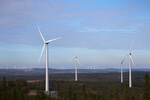News Release from windfair.net
Wind Industry Profile of
Money is no longer everything
Experts agree that offshore wind power will play a decisive role in the decarbonization of the world not just to produce electricity, but also to convert the energy generated into green hydrogen. According to a recent report by Wood Mackenzie, global investment in the offshore wind sector is expected to reach $1 trillion by 2030. There are only nine countries currently having offshore wind farms. Forecasting says that until 2030 at least 24 further nations will join with a totally installed capacity of about 330 gigawatts, up from 34 GW in 2020.
Last year alone, the pipeline grew by 66 percent - a figure that exceeds even the greatest expectations. Soeren Lassen, head of offshore wind research at Wood Mackenzie, explains, "Companies are now jostling to bag a share of the trillion-dollar offshore wind industry. As more companies bid, lease payments skyrocket and subsidies drop, project returns are falling. Cost competitiveness will always remain a central element of winning in offshore wind; however, a new set of factors beyond the bidding price is gaining traction, and this will determine who wins and who loses in the industry."
Countries are taking advantage of the companies' continued desire to push through more of their own interests in the future. Wood Mackenzie identifies four factors in this regard:
Local content factor:
Local content is playing an increasingly important role. If countries are leasing the seabed off their coasts the local economy should benefit. Wood Mackenzie estimates that 80 percent of new capacity in the coming decade will involve this policy.
The US example: The Americans have been working for more than a decade to set up their own offshore wind industry. They want to benefit and profit from the experience gained in Europe and Asia. The result is various joint ventures with local companies that benefit from the know-how of the established players. One example is the joint venture between Ørsted and Eversource. But the Jones Act also falls into this category: All ships for use in US waters must have been built in the US or controlled by a US owner.

Dominion Energy is among the first US companies to have a purpose-built Jones Act-compliant vessel for the offshore wind industry (Image: Dominion Energy)
System integration factor:
Offshore wind projects will be combined with other technologies and capabilities in the future to decarbonize more parts of the economy. A combination with solar plants, electrolysers and other technologies will become standard in the future.
Denmark is an example: the country is planning various so-called energy islands in the North and Baltic Seas that will combine offshore wind power, connection to foreign markets, storage and hydrogen production in different combinations.
Norway is an example: The country, which owes its wealth to the fossil raw materials oil and gas, plans - by state-owned company Equinor - to combine this form of energy production with offshore wind: with Hywind Tampen, floating offshore turbines are to supply the electricity needed to operate the oil and gas platforms.

As in this illustration, Equinor envisions the combination of fossil and renewable energy (Image: Equinor)
Ecological mitigation factor:
As the number of projects grows, so does the pressure on marine flora and fauna, whose protection is now more in focus. While measures such as bubble curtains to attenuate sound noise during installation are standard today, future projects will take an even more holistic approach.
Thus in the Netherlands in the upcoming wind power auction for the Hollandse Kust West area, the government will pay attention to innovative ideas on environmental protection and include them in the selection criteria. From the outset, interested parties must present a concept that includes such aspects.

A healthy ecosystem - despite wind power - is the goal (Image: Pixabay).
Sustainability factor:
How can the individual components of turbines be manufactured in a more environmentally friendly way? Can green steel be used to initiate a circular economy? The issue of recyclability is becoming more important. What happens to a wind turbine when it has reached the end of its life span? Are there deconstruction and recycling measures?
Industry example: in recent months, several turbine manufacturers have reported progress in the area of recycling, including Vestas and Siemens Gamesa.

How can the components be better recycled? The rotor blade in particular has been a challenge for companies so far (Image: Vestas)
Chris Seiple, vice chairman for Energy Transition at Wood Mackenzie, elaborates on the importance of these factors: "The focus is now shifting to multiple criteria to determine tender and lease auction outcomes, and the criteria in individual markets will differ. To succeed, investors need to be able to anticipate the important criteria in each market, have the capability and skills to execute and meet those criteria, and understand the trade-offs and synergies between them." Because it's already clear that not every country will value each of these factors equally.
Giles Dickson, CEO of WindEurope, is also convinced: "Non-price auction criteria will recognise the added value the European wind industry brings beyond simply offering cheap electricity. [...] It’s not just about price. It’s good the EU have blessed the use of non-price criteria. It’s now for Governments to use them – and to use them wisely."
- Author:
- Katrin Radtke
- Email:
- press@windfair.net
- Keywords:
- offshore, industry, market, criteria, auction, tender, government, interests, countries, costs, investment, wind farm








